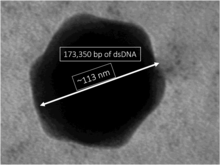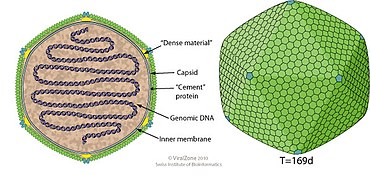| Prasinovirus | |
|---|---|
 | |
| Negative stained image of MpV-SP1 | |
| Virus classification | |
| (unranked): | Virus |
| Realm: | Varidnaviria |
| Kingdom: | Bamfordvirae |
| Phylum: | Nucleocytoviricota |
| Class: | Megaviricetes |
| Order: | Algavirales |
| Family: | Phycodnaviridae |
| Genus: | Prasinovirus |
Prasinovirus is a genus of large double-stranded DNA viruses, in the family Phycodnaviridae that infect phytoplankton in the Prasinophyceae . The genus contains two species, [1] [2] including Micromonas pusilla virus SP1, which infects the cosmopolitan photosynthetic flagellate Micromonas pusilla. [3]
Contents
There is a large group of genetically diverse but related viruses that show considerable evidence of lateral gene transfer. [4] [5]

